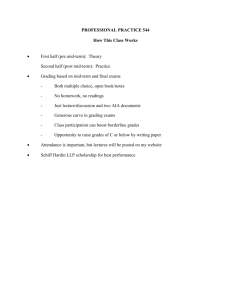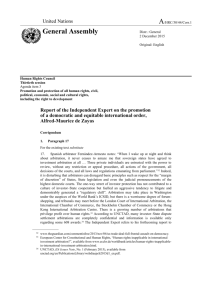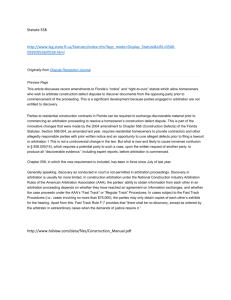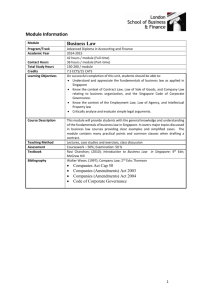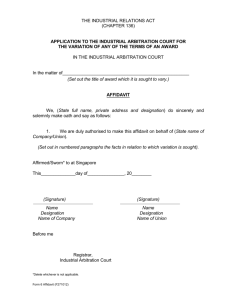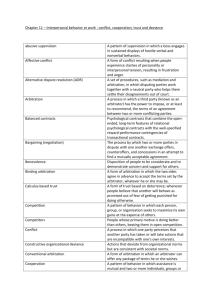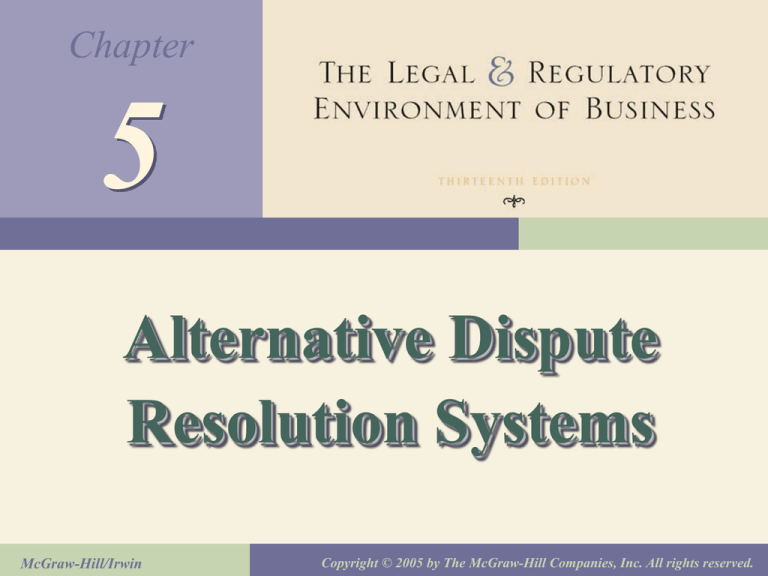
Chapter
5
Alternative Dispute
Resolution Systems
McGraw-Hill/Irwin
Copyright © 2005 by The McGraw-Hill Companies, Inc. All rights reserved.
Why ADR?
The mounting costs and delays inherent in the judicial system, the fact
that few cases were actually resolved by litigation; the escalating
confrontational nature of society; the difficulty of collection; the limited
nature of judicial remedies.
There are few things people dread more than litigation. Even minor cases
have a way of damaging relationships, tarnishing reputations, and eating
up enormous sums of time and money.
Behavioral Scientists say that the urge to compromise is instinctive, that
most people do not like conflict and that they value the good opinion of
others.
Businessmen fear damage to reputation, exposure of trade secrets and
sky-high awards from plaintiff sympathetic juries. Non-litigation solutions
help to avoid all of these.
Professor Robert F. Cochran, in the June 1993 issue of Arbitration
Journal suggested that “Lawyers who fail to present the option of
pursuing alternatives to litigation may be at risk of attorney discipline or
malpractice liability.”
The CPR Institute for Dispute Resolution reports that some 4,000
corporations have signed a pledge to seriously explore using ADR before
pursuing litigation and some 1,500 law firms have pledged to assure that
their attorneys are knowledgeable about ADR
5-2
Alternative Dispute
Resolution Systems
Expense
Time, Cost, Emotions
Most
Least
Trial &
Appeal
Mock
Trial
Arbitration
Negotiated
Minitrial
Settlement
Mediation
5-3
Reasons For
Settlement Without Litigation
Costs
• Attorney’s Fees
• Court Costs
Personal Reasons
• Compromise Is Instinctive
• Dislike Of Trouble
• Opinion Of Others
Business Reasons
• Bad For Business
• Sympathetic Juries
5-4
Means of
Dispute Settlement
Negotiation
• Primary benefits
Expediency
Minimize animosity
Avoid of the costs of litigation
Alternative Dispute Resolution (ADR)
• Mediation - neutral 3rd party facilitates
negotiations and may propose a basis for
settlement (mediation agreement)
5-5
Means of
Dispute Settlement
Alternative Dispute Resolution (ADR)
• Arbitration-neutral 3rd party decides the outcome
Circuit City v. Saint Clair Adams
Supreme Court held that a mandatory arbitration agreement that an
employee was required to sign when he applied for his job is covered by the
Federal Arbitration Act and is therefore enforceable. Case shows the
strong support for ADR, even when important issues of
public policy are involved. Note: Cases that go
through ADR usually have no public reporting or
oversight. The main impetus for this judicial
preference is the growing caseload of courts and the
fact that public funding has not kept up with the
increases. This was a 5-4 decision. The issue of
forcing employees to sign arbitration agreements is
controversial, and a bill was introduced in Congress
after the decision was handed down to make
arbitration agreements voluntary. In some states,
where the arbitration clause is not obvious, or the
party to the contract has no choice but to sign, and
the contract involves something important like a job,
5-6
the state court will refuse to force the party to
Means of
Dispute Settlement
Alternative Dispute Resolution (ADR)
• Minitrial - Disputing party executives
•
•
•
•
preview evidence and likely trial
outcome as an aid to negotiation
Summary Jury Trial – “mock” jury trial
to encourage and aid settlement
Citizen Review
Shows Plaintiff What to Expect
Private Judging - binding decision by
“rent-a-judge (e.g. “People’s Court”)
5-7
Alternative Dispute Resolution
Negotiation
• Parties make offers and counter-offers for settlements.
• May be face-to-face or through lawyers.
Mediation
• Neutral person (mediator) attempts to get parties to reach a
voluntary settlement.
• Mediation may be ordered by a judge.
• Mediator does not render a decision.
Arbitration
• Neutral person (arbitrator) is involved.
• Arbitrator does render a binding decision.
• Arbitration may be mandatory, if chosen in advance as the
method for dispute resolution.
5-8
Alternative Dispute Resolution
Mini-trial
• Parties stage a short trial to a panel of three “judges.”
• Two of the “judges” are executives of the disputing
corporations; the third is a neutral party.
• Lawyers present shortened cases; “judges” discuss
settlement.
• Confidential
• Focus On Central Issues
Summary Jury Trial
• Initiated and supervised by a court.
• Each side summarizes to a mock jury what witnesses would
say if called before a real jury.
• Jury deliberates and tries to reach consensus, but may vote
individually if necessary.
• Allows each side to see how a trial might turn out.
5-9
Negotiation
Negotiation is a bilateral method of dispute
resolution.
Typically, parties make offers and counteroffers.
Negotiations may be direct, even face-toface, or performed through the use of
intermediaries, such as lawyers.
Acquiescence may be viewed as negotiation
with little debate. One party states his or her
terms, and the other agrees.
5-10
Negotiation
Some typical situations that might involve
negotiation: as part of the sales process (by both
buyer and seller); between individuals for primarily
personal reasons (e.g. negotiating a pay increase or
remuneration package or ‘‘discussing’’ with your
spouse where to go on holiday); in wage bargaining
(as between an employer organization and a union or
staff group); in political circles (as in treaties between
governments); internationally (either between
individuals or organizations in different countries or
literally on a world wide basis – like the recent talks
about measures to combat global warming); and in
corporate affairs (takeovers, mergers and a variety of
alliances and collaborations, sought or forced by 5-11
Types Of Negotiations
Position-Based- Parties
State Opinions
Interest-Based
5-12
Positional Negotiation
High Price
Buyer’s
Resistance Point
Zone of
Agreement
Seller’s
Resistance Point
Low Price5-13
Positional Negotiation
High Price
Seller’s
Resistance Point
No Zone of
Agreement
Buyer’s
Resistance Point
Low Price5-14
Position-Based
Negotiations
‘‘There are two fools in
every market place. One
asks too little, the other
asks too much.’’ Traditional
Russian proverb
5-15
Interest-Based
Negotiations- Elements
Communication- Share Complaint, Joint
Problem
Relationship- Discuss Benefits By
Continuing
Interests- Mutually Exclusive?
Options- Not A Proposal For Compromise
Legitimacy- Accepted Standards
Alternatives- Possible Outcomes Without
Negotiation
Commitment- Realistic
5-16
Interest-Based
Negotiations
3 Types of Interests (also called the 3 “C”s;
see Steve Cohen, Negotiating Skills for
Managers)
Common interests: Those interests shared
by the negotiating parties who want the
same things for the same reasons.
Complementary interests: Those interests
that exist when the negotiating parties want
the same result, but because it will serve
different interests.
Conflicting interests: Those interests that
exist when one or more negotiators’
interests are in opposition to interests of
other negotiators.
5-17
Principled Negotiation
Principled negotiation involves: 1) Separating the
people from the problem: avoiding personalities and
emotions (or flagging them openly), understanding
the other’s point of view, and ensuring every aspect
of clear communications. 2) Focusing on interests,
not positions: here the distinction is that position is
something decided upon, whereas interests
influence the position adopted. 3) Inventing options
for mutual gain: usually defined as searching for a
larger cake, rather than arguing over the size of
slices. 4) Insisting on objective criteria: this focuses
discussion on criteria independent of people’s
(perhaps stubbornly) held positions and promotes a
‘‘win-win’’ outcome.
5-18
The Value of Silence in Negotiation
‘‘Silence is even better than asking
questions if the mood is right; it is
always a hard argument to counter.
Your opponent will give away his
thoughts, approach, opinions, strategy.
Talk less; learn more. There is a weight
in silence, a great value in an interval
in presenting your argument, an
influential thoughtfulness in a pause.’’
Michael Shea, author and former press
secretary to Queen Elizabeth
5-19
Negotiation
An “iceberg” in the context of negotiation is
a hidden factor of major significance.
Some other key factors in the negotiating
process
• Power, perceived or actual.
• Burdens, financial & otherwise.
• Third-Party Impacts, like competitors.
• Legitimacy ( Credibility or Believability), which is
often based on one’s prior track record.
• Deadlines.
• Limited or Abundant Resources.
• Access to timely and accurate information
(Technology may be a factor here).
5-20
Negotiation
As to “good faith”, a distinction
needs to drawn between before
and after agreement. UCC § 1-203,
imposes an obligation of good
faith in the performance of an
agreement. The Code however is
silent and therefore does not
impose an obligation of good faith
in the negotiation of the
agreement.
5-21
Negotiation
Ten steps to Successful Negotiation
(from “Negotiating” by Patrick Forsyth)
•
•
•
•
•
•
•
•
•
•
1) Preparation
2) Communicate clearly
3) Look the part
4) Respect the people
5) Aim High
6) Get their shopping list
7) Keep searching for variables
8) Utilize the techniques
9) Manage and control the process
10) Be ever on your guard.
5-22
Mediation
Third Party Assists In
Resolving Dispute- Avoid
Litigation
Parties Agree To Use
Reduces Court Caseload- No
Judicial Review
Settlement = Mutual Choice
5-23
Mediation
Advantage To Parties
• Determine To Pursue
• Retain Control Of Outcome
Disadvantage
• No Enforcement
• Selection Mediator- Qualifications
5-24
Mediation
According to a Cornell survey conducted in 1997 by the
Foundation for the Prevention and early Resolution of
Conflict:
• 81% say mediation provides a more satisfactory
process than litigation
• 66% say is provides more satisfactory results
• 59% say it preserves good relationships
• 79% of voluntary cases settled
• - G.F. Phillips, What your client needs to know about
ADR, Dispute Resolution Journal, Vol. 55 (2000)
5-25
Mediation
Private mediation introduces a third party as an
intermediary between disputing parties. The
private mediator is hired by the parties, is
neutral, and directs the process. The parties
retain the power to resolve the dispute.
Court-sponsored mediation may be offered (or
ordered) by a court and becomes part of the
litigation process. Therefore, the overall
process begins with a formal complaint stating
a legal cause of action that is filed with the clerk
of the court. A court-appointed mediator
(sometimes called a settlement judge) controls
the mediation process, and the parties control
the outcome of their dispute.
5-26
Mediation Procedures
Informal- Controlled By Parties
Mediator
Opening Statement/Rules
Parties
•View Statement
•Exchange
•Discuss Options- Caucus
Agreement
Written/Signed
5-27
Mediation
Church-Sponsored Mediation/Conciliation has existed in the United
States since Colonial times.
An example of a “Conciliation Clause” from a modern church
constitution & bylaws: “The parties to this agreement are Christians
and believe that the Bible commands them to make every effort to
live at peace and to resolve disputes with each other in private or
within the Christian church (see Matt.18:15-20; 1 Cor. 6:1-8).
Therefore, the parties agree that any claim or dispute arising from or
related to this agreement shall be settled by biblically-based
mediation or, if necessary, legally binding arbitration. Judgment upon
an arbitration decision may be entered in any court otherwise having
jurisdiction. The parties understand that these methods shall be the
sole remedy for any controversy or claim arising out of this
agreement and expressly waive their right to file a lawsuit in any civil
court against one another for such disputes, except to enforce an
5-28
arbitration decision.”
Mediation
The National Mediation Board was
created in 1934 to deal with
labor/management disputes, primarily
in the transportation arena, such as
airlines or railways.
5-29
Arbitration
Virtually any commercial
matter can be submitted for
arbitration.
Most states have statutes
based on the Uniform
Arbitration Act of 1955 under
which arbitration clauses will
be enforced.
5-30
Federal Arbitration Act
Enacted 1925
Revised/Reenacted 1947
Policy
• Interstate Commerce
• Favors Use
State Law- Supremacy Of U.S.
Constitution/Commerce Clause
5-31
Arbitration
Circuit City v. Saint Clair Adams
Supreme Court held that a mandatory arbitration agreement that
an employee was required to sign when he applied for his job is
covered by the Federal Arbitration Act and is therefore
enforceable. Case shows the strong support for ADR, even
when important issues of public policy are involved. Note:
Cases that go through ADR usually have no public reporting or
oversight. The main impetus for this judicial preference is the
growing caseload of courts and the fact that public funding has
not kept up with the increases. This was a 5-4 decision. The
issue of forcing employees to sign arbitration agreements is
controversial, and a bill was introduced in Congress after the
decision was handed down to make arbitration agreements
voluntary. In some states, where the arbitration clause is not
obvious, or the party to the contract has no choice but to sign,
and the contract involves something important like a job, the
5-32
state court will refuse to force the party to arbitrate.
Federal Arbitration Act
Doctor’s Associates, Inc. (DAI) is the franchisor of Subway sandwich shops.
Casarotto sought and was awarded a Subway franchise in Great Falls, Montana.
DAI’s franchise agreement contained an arbitration clause on page nine. A
dispute arose, and Casarotto sued DAI in Montana’s court. DAI moved to have
the case stayed pending arbitration. The trial court granted DAI’s motion.
Casarotto sought review, and the Montana Supreme Court reinstated the lawsuit
since the arbitration clause was invalid under Montana law. This law required
arbitration clauses to appear on the first page of a contract with the clause being
in capital letters and underlined. DAI was granted certiorari by the U.S. Supreme
Court. Issue: When the Federal Arbitration Act conflicts with provisions of a
state law, which one should be enforced? Held: The Federal Arbitration Act.
Federal laws are supreme when compared to state laws. The Federal Arbitration
Act allows state laws to override an arbitration clause only if the state law voids
the entire contract. Since the Montana law concerns the validity of the arbitration
clause and not the entire contract, the state law cannot be enforced. Doctor’s
Associates, Inc. v. Casarotto, 116 S.Ct. 1652 (1996).
5-33
Typical
Arbitration Contracts
1) Stockbroker & 5) Collective
2)
3)
4)
Client
Commodities
Broker &
Customer
Brokerage
Firm &
Employee
Attorney &
Client
6)
7)
8)
Bargaining
OwnerContractor &
ContractorSubcontractor
Insurance Co.
& Insured
Public Carrier
& Shipper
5-34
Arbitration
Third Party (Arbitrator)
Makes Final Decision
Mandatory v. Voluntary
Final Decision (Award)Binding
Reasons
• Quick/Inexpensive Resolution
• Ease Court Dockets
• Expert Assistance
5-35
Arbitration- Submissions
Parties Agree To
Arbitration- Written
Specific Matters Agreed
To Arbitrate
Matters For Arbitration
• Questions Of Fact
• Questions Of Law
• Most Fact & Law
5-36
Arbitration
AT&T TECH., INC. v. COMMUNICATIONS WORKERS
106 S.Ct. 1415 (1986)
FACTS: A collective bargaining agreement provided
that the employer was free to exercise certain management
functions, including the termination of employees for lack
of work. During the course of this agreement, the employer
laid off seventy-nine workers. In response, the union filed
a grievance claiming that there was no lack of work. The
union sought arbitration of this dispute under the contract
provision that differences arising over the interpretation of
the agreement would be submitted to arbitration. The
employer refused to submit the grievance to arbitration on
the ground that the layoffs were not arbitrable. The union
then sought to compel arbitration of the issue by filing suit
in federal district court. The employer objected to this suit
on the grounds that an arbitrator should decide whether
the layoff issue should be submitted to arbitration.
ISSUE: Who decides in the first instance if an issue
is subject to an arbitration clause?
5-37
Arbitration
AT&T TECH., INC. v. COMMUNICATIONS WORKERS
106 S.Ct. 1415 (1986)
DECISION:
The courts.
REASONS:
1. Arbitration is a matter of contract and a
party cannot be required to submit to arbitration any
dispute which he has not agreed so to submit.
2. It is the court's duty to interpret the
agreement and to determine whether the parties intended
to arbitrate grievances concerning layoffs predicated on a
lack of work as determined by the employer.
3. If the court determines that the agreement
requires a dispute to be submitted to arbitration, then it is
for the arbitrator to determine the relative merits of the
parties' substantive interpretations of the agreement.
4. A court, in deciding the arbitrability issue,
is not to rule on the potential merits of the underlying
claims.
5-38
Arbitrators
Chosen By Disputing Parties
Expertise
• Knowledge of “Common Law Of
Shop”
• Beyond Legal Expertise
Number = 1 – 3
Authority- Granted By
Agreement
5-39
Arbitrators
HOWSAM v. DEAN WITTER REYNOLDS, INC.
123 S.Ct. 588 (2002)
FACTS:
As a client of the Dean Witter Reynolds
brokerage firm, Karen Howsam invested in four limited
partnerships. These investments were made between 1986 and
1994. The client agreement signed by Howsam required all
disputes with Dean Witter Reynolds to be arbitrated. When she
lost money on her investments Howsam filed for arbitration
claiming that Dean Witter Reynolds had misrepresented the
investments in the limited partnerships. The NASD’s arbitration
agreement has a six-year statute of limitations. Dean Witter
Reynolds filed a lawsuit seeking to have the arbitration
submission enjoined since the statute of limitations had run
out.
ISSUE: Who, a judge or an arbitrator, makes the decision
concerning the application of a statute of limitations to an
arbitration proceeding?
5-40
Arbitrators
HOWSAM v. DEAN WITTER REYNOLDS, INC.
123 S.Ct. 588 (2002)
DECISION: The arbitrator.
REASONS: 1. Judges decide issues of arbitrability.
2. Arbitrators, however, resolve gateway
procedural disputes.
3. The application of a statute of limitations
to the timeliness of an arbitration proceeding is a
gateway procedure; therefore, its application is to be
resolved by the arbitrator.
5-41
Arbitration- Awards
Required- Disclosure Of
Findings & Reasons
Opinion Letter
Parties
• Frame Issues
• Define Arbitrator’s Scope
Court Favors Award
Final On Submitted Issues- Filed
With Court Clerk
5-42
Arbitration- Awards
Mr. & Mrs. Mastrobuono opened an investment and
trading account with Shearson Lehman Hutton, Inc.
The paperwork signed to open an account contained
an arbitration clause. A dispute over the handling of
the Mastrobuono’s account arose and an arbitration
was held. The arbitrator awarded the Mastrobuonos
$159,327 in compensatory damages and $400,000 in
punitive damages. Shearson Lehman Hutton objected
to the award of punitive damages. Issue: Can an
arbitrator, under the terms of this arbitration clause,
award punitive damages? Held: Yes. The New York
law, which is applicable state law, does not prohibit
the arbitrators’ award of punitive damages. The
arbitration clause and the securities industry do not
exclude the award of punitive damages.
5-43
Arbitration Awards
Final Offer Arbitration = Where
an arbiter’s award cannot be
more or less than a predetermined high/low range.
Baseball Arbitration = Where
arbiter’s award is limited to
the choice between the
parties’ last offers.
5-44
Mandated Arbitration
States Adopting
Speeds Up Process
Many Qualified
Arbitrators
Types Of Cases
• <$15,000
• Specific Subject Matter
Record Of Proceedings
Required
5-45
Mandatory
Arbitration- Procedures
Submit Claim
Discovery
Arbitrator Determines:
Admissibility Of Evidence
Law/Facts Of Case
Objections
8 Months
Hearing
5-46
Voluntary And
Contract-Based Arbitration
Parties Agree To Method
By:
• Original
Agreement/Contract
• Parties Agreement
Arbitration Clause- Does
Not Specify Cost
5-47
Mandatory Arbitration?
WRIGHT v. UNIVERSAL MARITIME SERVICE CORPORATION
119 S.Ct. 391 (1998)
FACTS:
Wright, a longshoreman who belonged to the
International Longshoreman’s Association, was injured and
received permanent disability benefits. After 3 years, Wright tried
to return to work. No company would hire him due to his receipt
of disability benefits. Despite the existence of an agreement to
arbitrate clause in the collective bargaining agreement, Wright
was advised by the union to hire an attorney and sue under the
American with Disabilities Act (ADA). When Wright sued the
union and six companies the defendants moved to dismiss since
this matter should have been arbitrated not litigated. The Fourth
Circuit Court of Appeal held for the defendants, dismissed
Wright’s suit, and ordered arbitration.
ISSUE: Does the arbitration clause in the collective
bargaining agreement prevent the litigation of claims under the
ADA?
5-48
Mandatory Arbitration?
WRIGHT v. UNIVERSAL MARITIME SERVICE CORPORATION
119 S.Ct. 391 (1998)
DECISION: No.
REASONS: 1. The Supreme Court reviews two lines of cases that
appear to conflict.
2. The Court determines it does not have to decide
which line of cases is correct since this arbitration clause does
not clearly and unmistakably incorporate employment
discrimination laws.
3. Thus, Wright may proceed with the lawsuit even
though no arbitration occurred.
5-49
Mandatory Arbitration?
GREEN TREE FINANCIAL CORP. v. RANDOLPH
121 S.Ct. 513 (2000)
FACTS: The contract arising from Larketta Randolph’s purchase
and financing a mobile home contained an arbitration clause
covering all disputes that might arise. When a dispute arose,
Randolph filed a lawsuit in federal court alleging violations of the
Truth-in-Lending Act and the Equal Credit Opportunity Act.
Randolph claimed the arbitration agreement was unenforceable
since it did not specify what Randolph might have to pay
associated with an arbitration proceeding. The District Court
dismissed Randolph’s lawsuit and ordered arbitration. The
appellate court reversed saying the lack of specificity of the
arbitration costs posed such a financial risk to Randolph that she
was entitled to protect her interests through litigation.
ISSUE: Is an arbitration agreement that doesn’t specify anything
about costs enforceable?
5-50
Mandatory Arbitration?
GREEN TREE FINANCIAL CORP. v. RANDOLPH
121 S.Ct. 513 (2000)
DECISION: Yes.
REASONS: 1. The Federal Arbitration Act reverses the historical
hostility courts had toward arbitration.
2. Statutory claims have successfully been handled
through arbitration proceedings.
3. Due to the court’s deference in favor of arbitration,
a party objecting to arbitration has the burden to prove rights will
be denied through arbitration.
4. Randolph failed to prove the costs of arbitration
were so substantial as to deny her a proper forum to resolve her
claims.
5-51
Mandatory Arbitration?
One line of cases (Alexander v. Gardner-
Denver Co.) holds that an employee does not
forfeit the right to litigate a claim of
discrimination even though he or she signs an
employment contract containing an arbitration
clause. The second line of cases (see Gilmer
v. Interstate/Johnson Lane Corp.) holds that
the federal policy favoring arbitration means
employees who sign employment contracts
containing arbitration clauses do waive their
right to litigate claims of discrimination.
5-52
Mandatory Arbitration?
Robert Gilmer worked as a financial services manager for
Interstate/Johnson Lane. As a condition of this employment,
Gilmer signed a contract containing a clause that all disputes with
Interstate would be submitted to arbitration. Interstate terminated
Gilmer’s employment. Gilmer filed a lawsuit, and Interstate
moved to dismiss the complaint on the basis that the parties must
arbitrate, not litigate. The district court denied Interstate’s motion,
but the court of appeals reversed. Issue: Did Congress intend to
preclude ADEA claims from being arbitrable? Held: No. Gilmer
makes five arguments as to why ADEA claims should be decided
by courts and not by arbitrators. All five of these arguments are
rejected. The Court concludes that Gilmer failed to meet the
burden of establishing that Congress intended to preclude
arbitration of claims under ADEA. Gilmer v. Interstate/Johnson
Lane Corp., 111 S.Ct. 1647 (1991).
5-53
Judicial Review
Of Arbitration
Voluntary/Contract-Based
•
•
•
•
Award Is Final
Findings Of Fact/Law- Conclusive
Limited
Correct Fraudulent/Arbitrary
Actions/Against Public Policy
Statutorily-Mandated
• In Accord With Procedural/Due Process Law
• De Novo
• Federal Arbitration Act
5-54
Overcoming Arbitration Clauses
in Fraud in the Inducement Cases
The U.S. Supreme Court in
First Options of Chicago v.
Kaplan, 514 U.S. 938 (1995)
ruled that if a matter involves
a claim of fraud in the
inducement, it must be
decided by a court (i.e.
litigated)
5-55
Summary Jury Trial
This process leads up to the opportunity for the parties to discuss
the resolution of the dispute, but this opportunity is not a part of the
process. Therefore, the process takes the parties to the doorstep of
resolution.
A Summary Jury Trial, or “Mock” jury trial is designed to encourage
and aid settlement. It is usually initiated and supervised by a court.
Each side summarizes to a mock jury what witnesses would say if
called before a real jury. The jury deliberates and tries to reach
consensus, but may vote individually if necessary. This allows each
side to see how a trial might turn out.
Summary jury trial ends with the parties receiving the jury’s verdict
(if one is reached) and the jurors’ evaluation of the case. About 95%
of all cases are settled relatively quickly after the jury's verdict.
Note: Federal District Judge Thomas Lambros invented the
summary jury trial, in his Cleveland courtroom in 1983.
In this process, the parties must evaluate what they have heard and
5-56
then enter settlement discussions.
Mini Trial
A mini-trial is not a trial. It is designed for corporate-type
disputes, and has two stages. Mini-trials are usually
private processes and not court-sponsored, although
there is no reason why a judge could not host a mini-trial
and be the neutral third party.
In a mini-trial, the disputing party executives preview
evidence and the likely trial outcome as an aid to
negotiation. Parties stage a short trial to a panel, usually
of three “judges.” Normally, two of the “judges” are
executives of the disputing corporations; the third is a
neutral party. Lawyers present shortened cases;
“judges” discuss settlement.
5-57
Mini Trial
The 2 stages of a Mini-Trial
• The first stage is the summary presentation
of evidence by the attorneys for each
corporation to the panel (a decision maker
from each corporation and a neutral third
party).
• The second stage is a negotiation between
the two corporate representatives who were
members of the panel or a mediation that
includes the neutral third party as the
mediator.
5-58
Mini Trial
The mini-trial is discussed after court-sponsored mediation because
the first stage of the mini-trial, with its opening statement, formal
presentation of facts, and closing argument, appears more
adversarial than mediation. The mediation may occur in the second
stage when the panel members discuss possible settlement.
One well-known case of a successful mini-trial involved Allied
Corporation and Shell Oil. After five or six years of bickering over a
contract dispute, Shell finally filed suit. Four years later, legal fees
had consumed hundreds of thousands of dollars and pretrial
discovery was not yet complete. Attorneys for both companies
decided to use the mini-trial in a final effort to resolve the case
without a trial. After a short hearing, the parties settled the ten-yearold dispute almost at once.
5-59
ADR Trends
Professor Robert F. Cochran, in the June 1993 issue of
Arbitration Journal suggested that “Lawyers who fail
to present the option of pursuing alternatives to
litigation may be at risk of attorney discipline or
malpractice liability.”
The CPR Institute for Dispute Resolution reports that
some 4,000 corporations have signed a pledge to
seriously explore using ADR before pursuing litigation
and some 1,500 law firms have pledged to assure that
their attorneys are knowledgeable about ADR
5-60
ADR Trends
Med-Arb = a joining
mediation and arbitration,
where the parties start out in
mediation, but if they fail to
reach agreement the process
shifts to arbitration.
5-61


